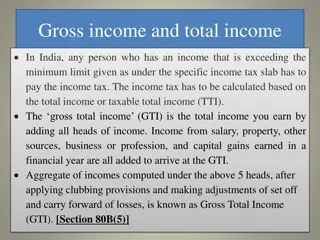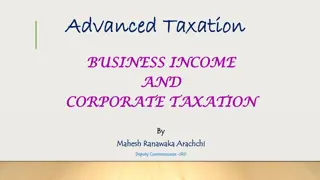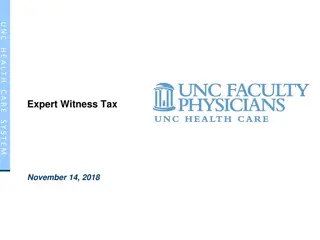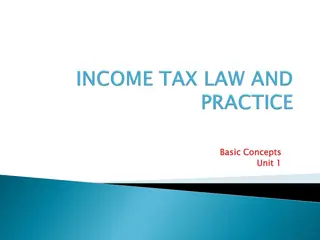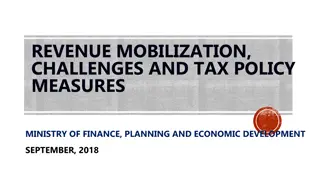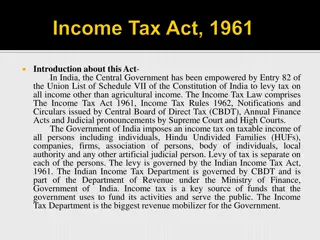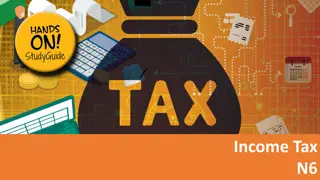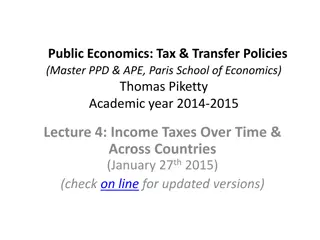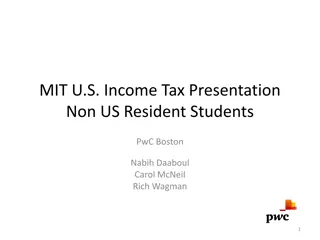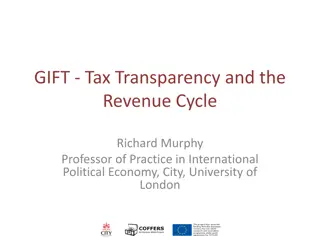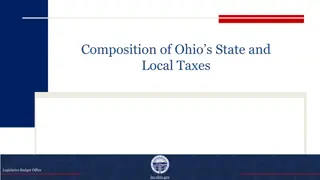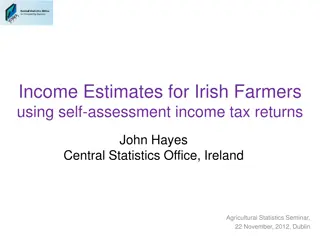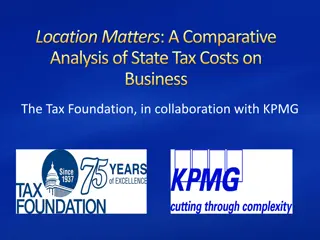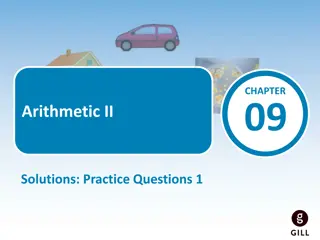
Comprehensive Guide to Income Tax and National Insurance
Explore various types of taxes, including income tax and national insurance. Learn about different tax rates and how they affect individuals based on their income levels. Get insights into the amount of tax paid and take-home income for different professions such as Secretary, Dentist, Engineer, and CEO. Understand the complexities of taxes and how they impact personal finances.
Download Presentation

Please find below an Image/Link to download the presentation.
The content on the website is provided AS IS for your information and personal use only. It may not be sold, licensed, or shared on other websites without obtaining consent from the author. If you encounter any issues during the download, it is possible that the publisher has removed the file from their server.
You are allowed to download the files provided on this website for personal or commercial use, subject to the condition that they are used lawfully. All files are the property of their respective owners.
The content on the website is provided AS IS for your information and personal use only. It may not be sold, licensed, or shared on other websites without obtaining consent from the author.
E N D
Presentation Transcript
Tax One of the only two certainties in life
Types of Tax List as many types of tax as you can Which of these are compulsory taxes and which are voluntary?
Types of Tax List as many types of tax as you can Which of these are compulsory taxes and which are voluntary? Income tax National insurance Council tax Capital gains tax Vehicle Excise Duty (VED) Stamp duty VAT Inheritance tax
How much income tax would the people below pay, and how much money do they take home? a) Secretary, 22,000 c) Dentist, 72,000 b) Engineer, 48,000 d) CEO, 200,000 Personal Allowance Basic Rate Higher Rate Additional Rate Up to 12,570 12,571 - 50,270 50,271 - 125,140 above 125,140 0% 20% 40% 45%
How much income tax would the people below pay, and how much money do they take home? Jan 23 = 16,232 / 55,768 Jan 24 = 16,292 / 55,708 Jan 23 = 1,886 / 20,114 Jan 24 = 1,886 / 20,114 a) Secretary, 22,000 c) Dentist, 72,000 b) Engineer, 48,000 Jan 23 = 7,086 / 40,914 Jan 24 = 7,096 / 40,904 d) CEO, 200,000 Jan 23 = 69,932 / 130,068 Jan 24 = 71,175 / 128,825 Personal Allowance Basic Rate Higher Rate Additional Rate Up to 12,570 12,571 - 50,270 50,271 - 125,140 above 125,140 0% 20% 40% 45%
How much national insurance would the people below pay, and considering this alongside income tax, how much money do they take home? a) Secretary, 22,000 c) Dentist, 72,000 b) Engineer, 48,000 d) CEO, 200,000 Lower Earnings Limit Upper Earnings Limit Higher Rate Up to 12,576 12,576.01 - 50,268 Above 50,268 0% 12% 2%
How much national insurance would the people below pay, and considering this alongside income tax, how much money do they take home? ANSWERS NI = 1,131.60 Take home = 18,982 TAX = 1,886 TAX = 16,232 NI = 4958.60 Take home = 50,709.40 a) Secretary, 22,000 c) Dentist, 72,000 b) Engineer, 48,000 TAX = 7,086 NI = 4251.60 Take home = 36,662.40 d) CEO, 200,000 TAX = 69,932 NI = 7,518.60 Take home = 122,549.40 Lower Earnings Limit Upper Earnings Limit Higher Rate Up to 12,576 12,576.01 - 50,268 Above 50,268 0% 12% 2%
Pension payments are deducted from salaries before tax and national insurance and thereby reduce the amount of income upon which tax and NI is due Assuming each of our employees pay pension contributions of 10% of their salary A. How much do they contribute towards their pension each year? B. How much tax & NI do they pay now and how does this compare to before? C. What is their take home pay now?
How Does PAYE Work? The UK tax year runs from 6th April to 5th April the following year. The system by which employers deduct income tax from employee wages via PAYE is really logical and clever. It adds up earnings and tax paid for the current year, assumes that current monthly earning will continue for the rest of the year then projects the likely total tax due and splits this equally between remaining months. As the year progresses, these totals are refined until they are consolidated to meet the total tax due in the final month of the tax year.
How Does PAYE Work - Example 1 The employee earning 29,600 pa who gets a 1000 pay rise in July and another 1000 pay rise in October. Paid monthly on 5th of each month.
How Does PAYE Work - Example 2 The holiday employee who earns 1300 over Easter then 2600 over the summer and 1300 over Christmas. Paid on 5th of May, August, September and January.
Tax Avoidance. vs Tax Evasion Tax avoidance through sensible and legal financial planning is legal and sensible Tax evasion through lying or non-declaration is illegal and naughty
This Week's Top Tips https://www.moneysavingexpert.com/latesttip/ 7th Feb 2023 Car insurance up 15% - check NOW if you can save 100s Top easy-access children's savings 3.75% for age 7-17 UK-born children aged 12 to 20ish had a Child Trust Fund opened in their name with 250 or 500 automatically added. How much will you need to save for your children's uni? https://www.moneysavingexpert.com/deals/



